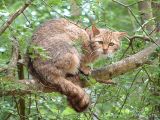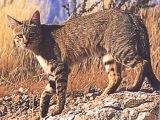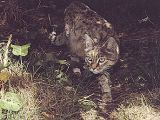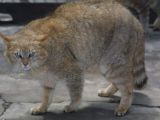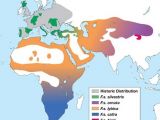In the case of cats, we really have doubts on whether they are really domestic or just live with us under the same roof. But as any domestic animal, cats too come from a wild animal. But the wild species (Felis sylvestris) lives in Africa, Europe and half of Asia. So the question is: where did the people domesticate the cat?
Now DNA analysis have detected the house cat's maternal ancestors back to the Fertile Crescent (Egypt-Israel-Mesopotamia (today Iraq)-Syria-Cyprus). The Middle Eastern wild ancestors still wander through the deserts of the area. This wild breed seems to have originated in a population that lived between 70,000 and 100,000 years ago, producing the genetic lineage that eventually included all domestic cats.
"It's plausible that the ancient [domestic cat] lineages were present in the wildcat populations back as far as 70,000 or 100,000 years ago," said study co-author Stephen O'Brien of the National Cancer Institute in Frederick, Maryland.
"The wildcats may have been captured around 10,000 or 12,000 years ago when humans were settling down to farming. One of nearly 40 wild cat species existing at that time, the little wildcat that lived in the Middle East had a genetic variance that allowed it to sort of try an experiment-let's walk in and see if we can get along with those people," O'Brien said.
The team encountered five matriarchal lineages in the modern domestic cats. "This tells us that domestic cats were sort of widely recruited, probably over time and space," said lead researcher Carlos Driscoll of the National Cancer Institute.
But the cat's domestication occurred in a different way than it happened with other species.
"The cats just sort of domesticated themselves. People today know that you can't keep a cat inside [without barriers], and 10,000 years ago in the Fertile Crescent you couldn't just shut the window."
People were interested in attracting wildcats, as they destroyed rodents infesting the farm fields and grain barns in the settlements of the early farmers. Cats proved also able to adapt to cities and towns. In fact, ancient Egyptians, 5,000 years ago, were known to adore cats, and they even worshiped a Cat Goddess, Bastet, represented as a woman with a cat's head. Bastet was the Goddess of Joy, Peace, Art, Music, Dance, Fertility, Sexual rites, Mother-hood, Marriage, Benevolence, Pleasure, Intuition, Healing and Protection against disease and evil spirits.
"There are some 600 million house cats around the world. Domestication was one hell of a successful natural experiment." said O'Brien.
Once turned into household companions, cats accompanied prehistoric human tribes in their migration worldwide, explaining the origin of all domestic cats from the same stock.
"In the same way, domestic cats from Europe are really the same as domestic cats from Israel or China or wherever." said Driscoll.
The oldest remains of a domestic cat have been discovered in Cyprus, being about 9,500 years old. But cats, unlike other domestic animals, have changed very little compared to their wild ancestors, that's why sometimes it's hard to tell the difference between feral and really wild individuals, and interbreeding has resulted in many hybrids of the two. DNA analysis is the most precise way to determine which cats are truly wild.
In this research, the scientists sampled a thousand wild and domestic cats, coming from modern wildcat subspecies: the Near Eastern wildcat, the European wildcat, the Central Asian wildcat, the southern African wildcat, and the Chinese desert cat. The gene sampling showed that the domestic cat was closest to the Near Eastern wildcat; having the same genetic clade (coming from a common stock), those wildcats generated the domestic ones.
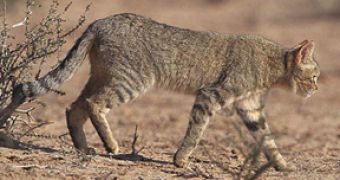
 14 DAY TRIAL //
14 DAY TRIAL // 
